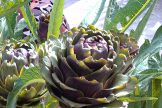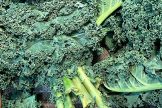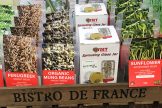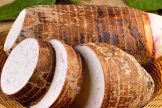
 Important note about plant availability. Important note about plant availability.There are hundreds of factsheets on our website provided for your information. Not all plants will be available at all times throughout the year. To confirm availability please call (03) 8850 3030 and ask for the nursery. |
This group have so many different common names: we will try to cover them all and nail them down.
Radicchio Cichorium intybus
Also called Italian chicory, red endive and red chicory. Originating in the northern Italy town of Chioggia, giving the most commonly grown variety its full name of Radiccio Rosso di Chioggia. Similar in form to a cabbage but with vibrant purple red leaves and stark white ribs. Eaten fresh, it has a bitterness that cuts into rich fatty foods like salamis, prosciutto and pancetta, as well as soft and hard cheeses. The flavour contrasts well with the sweetness of pears and the saltiness of anchovies. Radiccio salad with pears, blue cheese, anchovies, prosciutto and scattered candied pecans, light balsamic dressing – heaven on a plate. Growing in Melbourne: Grow in a sunny spot over winter. Will cope easily with a light frost. Our hot summers tend to lead to bitterness, best in the cooler seasons. Protect from slugs and snails, but not particularly pest prone.

Sugarloaf chicory Cichorium intybus
Also called Long Green Chicory. Pale green leaves with white ribs tightly wrapped in a long slender head. A sweeter form of chicory, still bitter but milder. Wonderful in winter salads, but also useful in soups, pasta, stir-fries and risottos. Can be grilled, baked or sautéed. Growing in Melbourne: Grow in a sunny spot over winter. Will cope easily with a light frost. Our hot summers tend to lead to bitterness, best in the cooler seasons. Protect from slugs and snails, but not particularly pest prone.
Witloof, Belgian Endive Cichorium intybus var. Folosum
Also called chicory. Small creamy white heads around 15cm long with a mild nutty flavour. Generally cut out the core at the base as it is more bitter than the rest. Use as a salad vegetable or can be stir-fried, grilled, baked and sautéed. Microwaves well. Braise in butter, garlic, tiny pinch nutmeg and pinch of sugar with a small amount of water, don’t overcook. Store in a paper bag or something to keep the light out to prevent bitterness developing. Grow in the cooler months and pile soil around it to keep the sun away from the leaves, this keeps them blanched.
Root Chicory Cichorium intybus var. sativum
In this instance the roots rather than the leaves are used. Roasted and then ground to form a coffee alternative (of course we wouldn’t dream of a coffee replacement in Melbourne… and never ever in Lygon Street, Carlton).

Endive
Cichorium endivia var crispa (Curly Endive)
Cichorium endivia var latifolium (Broadleaf Endive or Escarole)
The Curly Endive gives that tart bitter spark to a salad while Escarole is usually cooked as a green vegetable and is much less common in Australia. Curly endive can be grown all year round, but is less bitter in the cooler months and when the plants are young. Shading the plants will also blanch them and reduce the bitterness. The inner paler leaves have a sweeter flavour. A week or so before harvest, you can lift and tie the outer leaves up around the plant, this blanches and sweetens the inner leaves. The bitterness goes exceptionally well with strong oily flavours like smoked salmon or Stilton Cheese.





